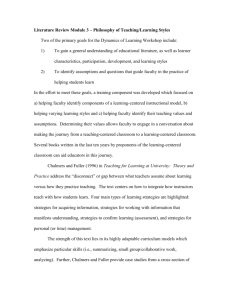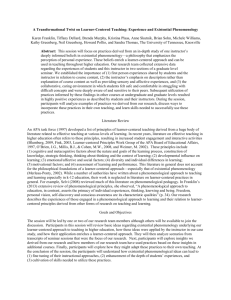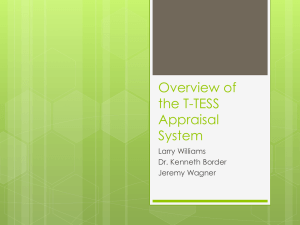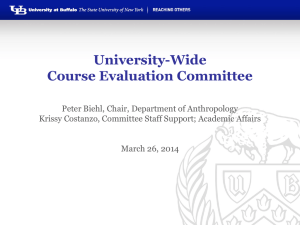A general introduction to learner
advertisement
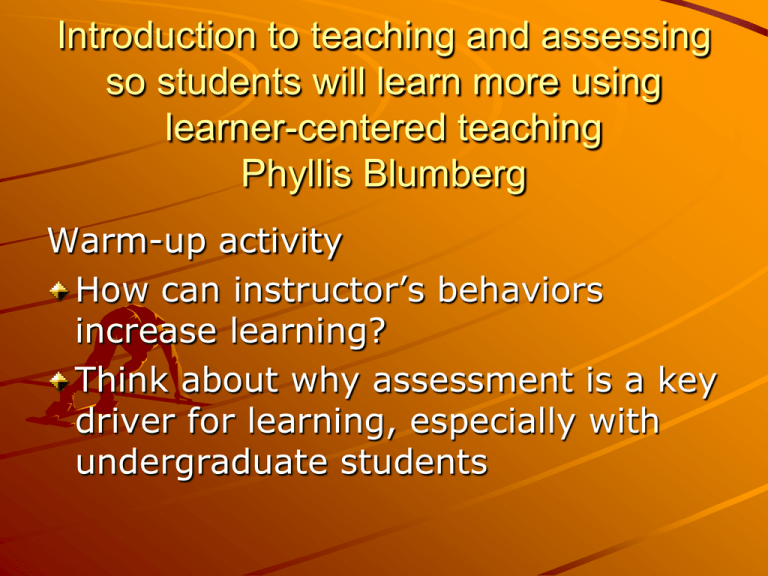
Introduction to teaching and assessing so students will learn more using learner-centered teaching Phyllis Blumberg Warm-up activity How can instructor’s behaviors increase learning? Think about why assessment is a key driver for learning, especially with undergraduate students At the end of this session you will be able to: identify characteristics of learnercentered teaching Discuss effective roles of instructors to increase learning discuss various purposes and processes of assessment formulate a plan to make specific changes in your teaching Some facts to help you implement learner- centered teaching Courses can be learner-centered without sacrificing content and rigor There are many different ways to implement learner-centered teaching Easier and more practical to make changes in one area at a time, or make small changes Faculty need to know and accept the advantages of learner- centered approaches before they will change their teaching Learner- centered teaching It is an approach to teaching that focuses on student learning – rather than on what the teacher is doing Learner-centered teaching is not one specific teaching method Many different instructional methods can use a learner-centered approach Why learner-centered approaches should be implemented? There is good evidence to support teaching this way. Educators are under increasing pressure to use learner- centered teaching Students/graduates of learnercentered programs Know why they need to learn and how to learn Have self awareness of their learning abilities and their process of gaining it Are responsible and are prepared to become informed citizens Can retrieve & evaluate information Use knowledge to solve problems Can communicate their knowledge in real settings Blumberg (2004) Beginning journey toward a culture of learning centered teaching. J of Student Centered Learning. 2(1), 6880. Support for why educators need to implement learner- centered teaching Comes from numerous sources: Learning theories Research on student learning and student engagement Accreditation requirements for professional programs and college accreditation agencies Regional accreditation standards are focusing on learning outcomes Accreditation agencies expect institutions to assess student learning outcomes – Assessment of student learning outcomes are fundamental to the accreditation process Focus on assessment of student learning is congruent with learner-centered teaching http://www.msche.org/publications/characteristics, Middle States Commission on Higher Education.(2003) Student Learning Assessment Divide and conquer works for implementing learner-centered teaching also According to Weimer (2002) there are 5 practices or dimensions that need to change to achieve learning centered teaching The functions of content The role of the instructor The responsibility for learning The processes and purposes of assessment The balance of power Weimer, M. (2002). Learner-centered teaching. San Francisco: Jossey-Bass. What do you do with content in a course? The Function of Content In addition to building a knowledge base, the content facilitates students to: – Build an appreciation for value of content – Build discipline-specific learning methodologies – Practice using inquiry or ways of thinking in the discipline – Learn to solve real problems The Function of Content (continued) Students engage in most of the content to make it their own, students make meaning out of the content Content can help students develop an organizing framework or way to learn in this discipline Content is framed so that students see how it can be applied in the future How do you decide how to conduct or teach the course after you selected the content to teach? The role of the instructor The instructor creates an environment that: –Fosters students learning –Accommodates different learning styles The role of the instructor (continued) Explicitly aligns objectives, teaching methods and assessment consistently Utilizes multiple teaching techniques appropriate for student learning goals Designs activities in which students interact with the material, the teacher and each other Motives students to learn intrinsically Who should take responsibility for learning? Who should take responsibility for learning? The students should Often it is the faculty who does because we adapt our teaching to fit requests/ needs of students through detailed notes, study guides Consequence of faculty taking responsibility for learning Students remain passive Students do not gain confidence in their ability to learn on their own Yet a common goal of higher education is for graduates to be self-directed learners who can continue to learn the rest of their lives Faculty need to teach students how to take responsibility for learning There are specific skills that can be taught, practiced and mastered Why do you assess students? How does the manner in which you assess students have learning implications or consequences for the students? The purposes and processes of assessment Assessment is integrated within the learning process Instructors give formative feedback for the purposes of fostering improvement Students have multiple opportunities to assess themselves and their peers Students can learn from their mistakes and then demonstrate mastery The purposes and processes of assessment (continued) Instructors encourage students to justify their answers when they do not agree with those of instructor. Instructor and students: mutually agree on a timeframe for feedback and always follows the timeframe for providing feedback Instructor uses authentic assessment throughout the course What happens if students have some control over how the course is run? The balance of power Learner-centered approaches empower students to take responsibility and to share in some of the decisions about their courses – Students can have some say over some policies, deadlines Allows students some grading options The balance of power Once students begin to gain some control over the course, they will engage more in the course and will learn more Peer teaching activity (13 minutes) Break into pairs For 3 minutes, each person studies a different dimension (a different colored sheet for each dimension) to prepare to explain it to the other person I will answer any questions or help you understand the dimension Then explain both dimensions spending about 5 minutes on each dimension and especially focusing on the examples Beginning to teach so students will learn more Changes in 1 dimension will lead to changes in another dimension You can start anywhere Making changes in your teaching Select one component of one dimension to focus on for the duration of the workshop We will form small groups of people working on the same dimension I have prepared questions to help guide you in your planning to make changes Forming Groups to Make changes Who wants to focus on the role of the instructor? Who wants to focus on assessment? Which components are you considering transforming? Once in the larger section for the chosen dimension, form smaller sub-groups working on the same component Select one component you want to consider Each component has specific questions to help you identify how you can change your course (spend 15 minutes on questions) – Questions are grouped by dimension – Components are labeled and numbered as they are on the tables you have Answer only the questions for the component you want to change Individually answer the questions about how you teach (usually in the middle of the questions) 2 part small group activity (20 minutes) Groups will be working on the same component Part 1- consider possible changes – Consider which changes you might make based on the discussion you just had – Agree upon 1-2 possible changes – Part 2- planning for transformation Discuss the answers to the questions on the planning for transformation form for the selected component Complete the planning for transformation form (green sheet) as a group or individually Use the form as a stimulus to plan how you can assist your students to learn more through the use of this component Pay special attention to the following tactical questions Answer tactical planning questions What do you need to do, decide prior to making changes? Identify obstacles or challenges that need to be overcome Identify strategies for overcoming obstacles Identify necessary resources How can you get students to accept this change? Discussion of next steps Any questions? Please complete the feedback form.

